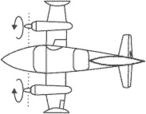Given an assumed mixing efficiency, these rates are roughly consistent with estimates of power going through the three primary mechanisms of internal wave generation: barotropic tidal flow over topography leading to internal tides (~1 TW; see the sections on "Near-field tidal mixing" and "Far-field internal tides"), low-frequency flows over topography producing internal lee waves (0.2-0.7 TW; see section on "Internal lee waves"), and variable wind forcing producing near-inertial internal waves (0.3-1 TW; see section on "Wind-driven near-inertial motions").
What follows in the sections below concerns first the main science efforts to consolidate our understanding of turbulence from 1) mixing elevated over rough topography related to internal wave generation by tides, 2) low-frequency flows that generate internal lee waves, and 3) near-inertial internal wave generation by winds.
Local mixing occurs through tidally generated, transient, arrested lee waves (Legg and Klymak 2008; Klymak et al.
For turbulence at tall, steep slopes, a new parameterization of the near-field mixing due to transient arrested lee waves (Klymak et al.
Available global estimates for the energy conversion rate from geostrophic flows into internal lee waves range from 0.2 to 0.75 TW and highlight a prominent role of the Southern Ocean (Bell 1975; Nikurashin and Ferrari 2011; Scott et al.
2014) using the estimated global map of energy conversion into lee waves of Nikurashin and Ferrari (2011; Fig.
(2013, 2016) implemented an inline wave drag parameterization (for both propagating and nonpropagating lee waves) from the atmospheric community (Garner 2005) into a high-resolution ocean general circulation model (Fig.
More observations are needed, especially in the Southern Ocean, to provide definitive evidence of the extent of propagating lee waves in the ocean and further to explore 1) the fraction of local dissipation and the vertical profile of dissipation of the propagating drag, 2) the relative importance of the propagating and nonpropagating lee-wave drag, and 3) the observed mismatch between estimates of lee-wave energy generation and near-bottom dissipation of lee waves.
Enhancing our knowledge of the near-bottom stratification and velocity fields and using a more accurate representation of topographic blocking are crucial for reducing our uncertainty about the global conversion rate into lee waves. Indeed, Wright et al.
(2015) showed that the energy flux into lee waves exhibits a clear annual cycle in the Southern Ocean and that the global energy flux is projected to decrease by ~20% from preindustrial to future climate conditions under the representative concentration pathway 8.5 (RCP8.5) scenario.
Lee waves may also contain significant power and play an important role in places like the Southern Ocean; preliminary results hint at a substantial role in water mass modification in this globally important region, but more observations and data-model-theory comparison is needed before we are confident of how best to represent them (see the section on "Internal lee waves"; Fig.

